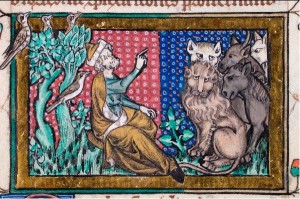Not native to the habitat
Most days I walk out the door, crossing what I just think of as “the grass,” get into my car and drive through a bunch of random foliage toward Canton. It’s nature, it’s the North Country, it’s easy on the eyes. But I have no real consciousness of what I am looking at while I sort out my day ahead.
But sometimes a single thing will catch my eye–moss in the grass, and tiny wildflowers, an odd beetle. I wander over to the verge and notice something unfamiliar twined into the mock orange bush, rooted among the periwinkle beneath, all partly shaded by white pine, in which it seems a family of robins has taken up residence.

Adam naming the animals of the world, from the Peterborough Bestiary (Cambridge, Corpus Christi College, MS 53, f. 195v, 14th Century)
Once you begin to see, there is no end to what you can see. It feels wonderful, but it also makes me feel ignorant and oblivious. For every species I can name, there are a hundred more I have no word for. Someone has named them all, or most, but I have never troubled to learn even that much about my neighbors.
Not even enough to know which are native, and which are imports, and which are invaders. I think I heard somewhere that there were only about 30 tree species native to the region. Shouldn’t an educated person know so few by sight and by name? Maybe if I hadn’t devoted quite so much time to fantasy and science fiction.
I admire people who catalog bird sightings and keep herbals and garden journals. We might think of them as hobbyists with eccentric taste in entertainment, perhaps, but what must they think of the rest of us who clutter up our memory with plots lines and characters names from TV drama? I can probably put a name to more typefaces than I can to flowers. Is that an accomplishment?
I was astonished to learn that such an ordinary creature as the earthworm is an invasive species in the Adirondacks. Long ago the glaciers scrapped the region clean to bedrock, and in the millennia since the earthworm never repopulated itself. Not until farmers brought them in to enrich their gardens in the early 19th century. They’ve been spreading out ever since. The old-growth forest that we lumbered off will never return the same, though we leave it uncut for a thousand years. Earthworms in the soil make for a whole different ecology.
Our ignorance and our cavalier actions have unintended consequences. I think of that every time I look back at the unkillable expanse of Japanese knotweed behind the house. A brief ornamental fad among landscapers of the Victorian era, japonica will wind up fighting the cockroaches for control of the planet long after we are gone.
Considering the Ice Age, we are none of us native to the habitat–not people, not trees, not grass. Some creatures just arrived a few thousand years before the rest. So, I suppose it won’t matter in the end who came first. And knowing the name of something is not the same as knowing it, anyway. But it would be something. Maybe make it a little harder to take it all for granted.
Tags: listeningpost





.png)


Dale:
Nice piece! You have a knack for combining insight and fact that is not only entertaining but thought provoking. But I believe that ticks will ultimately rule.
Jim
Thanks, Dale. Chris Martine, who taught botany at SUNY Plattsburgh, now at Bucknell, wrote a lovely column for Huffington Post on a similar thought. “It’s not until you start to know the things around you — learning their names and understanding how they live — that the world becomes surprisingly and comfortably familiar.” http://www.huffingtonpost.com/dr-chris-martine/back-to-school-the-world-_b_3830962.html?utm_hp_ref=tw
I think the character of a “backyard naturalist” is that you do notice plants, animals, bugs around you–you know where the poison ivy shows up every year, or the pattern of hummingbirds at feeders, or the impossible root depth of Japanese bindweed. However, it doesn’t necessarily mean you know the taxonomy. My old farmer friend Aldena Conklin had carried forward local names for a lot of flowers and plants, or made them up. And her husband Milan recognized and knew the growth habits of virtually every plant and flower on his 100 acre farm. But when I’d ask him the name of a particular flower, his answer was always the same, “Oh, that’s a posy,” and he’d smile. Sometimes, I guess, knowledge is non-verbal.
How many invasives would there be if the Europeans had never invaded North and South America?
How many invasives came in when the Native Americans invaded North and South America?
Does the word invasive have any real meaning beyond the words we use to name plants and animals?
The problem with naming things, including all the words we use to name different groups of humans, is they create the illusion of having control over and knowing something about things we real don’t know much about.
A beautifully written piece, Dale. There is always such feeling in what you write.
What a good, long perspective on not only our plant life but also our people. Which are the invasives? Who are the immigrants (legal or otherwise)?